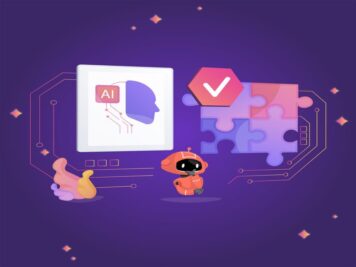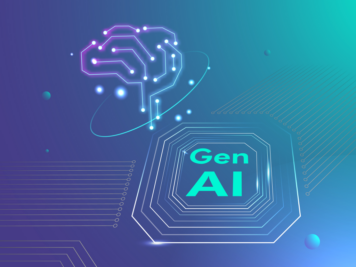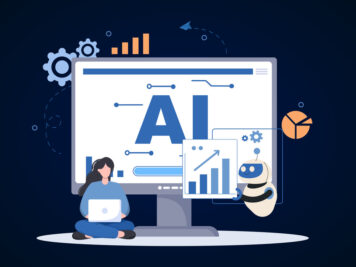AI trends in banking are rapidly reshaping the financial landscape.
We’re talking about a massive transformation, and Generative AI (GenAI) is leading the charge, opening up exciting new possibilities and advancements. In fact, Citi Bank predicts that AI implementation could boost the banking industry’s overall profits by a whopping $170 billion, a 9% jump, by 2028. Pretty cool, right?
So, how exactly is AI changing the way we bank? In a nutshell, AI is automating complex tasks, slashing operational costs, and making everything super efficient. Think of it this way: AI-powered predictive analytics helps banks make smarter decisions and offer you personalized financial products that truly fit your needs. Plus, it’s a superhero when it comes to spotting fraud and managing risks, keeping your money safe and sound.
Some banks were quick to jump on the AI bandwagon, and they’re already reaping the rewards – enjoying greater efficiency and a serious edge over their competitors. But don’t worry, others are catching up fast! Gartner expects that by 2026, over 80% of banks will be using GenAI, a huge leap from just 5% today. This shows just how much GenAI is set to disrupt the banking scene.
We’ve dug deep to identify the top 11 AI trends in banking that are set to make a big impact in 2025 and beyond. In this article, we’ll dive into how these advancements are creating fresh opportunities, beefing up security, and truly shaping the future of banking. Let’s get started!
1. Operating models for generative AI in banking.
The first trend on our list is the increasing use of centralized operating models for GenAI in banks.
A shift from decentralized data practice to a centralized operating model is taking root in banks. According to a recent survey by McKinsey & Company, more than half of companies, including technology giants with approximately $26 trillion in assets, have adopted a more centralized organization for generative AI.
But why is this shift happening?
GenAI presents a different set of challenges that a centralized approach can better address. These challenges include:
- Generation of inaccurate or illogical information.
- Violation of intellectual property rights
- Difficulty in understanding how the system works.
- Possible biases and unfairness in the results.
- Security vulnerabilities
Centralized monitoring ensures that pilot programs lay the foundation for larger-scale deployment and allows for more effective allocation of resources from scarce GenAI expertise. This collaborative environment promotes a sense of teamwork while attracting and retaining talent.
The idea is to strike the right balance. The ideal approach takes into account each bank’s unique structure and culture while ensuring scalability. A well-designed centralized model can ensure an effective implementation of GenAI and lay the foundation for an AI-driven future in banking.
2. Increased productivity in banking sector through GenAI
Generative AI is really shaking things up in banking this year. We are talking about huge leaps in productivity and efficiency! Its clear banks are seeing massive potential, with 58% of banking organizations fully embracing GenAI’s transformative power – that’s big jump from 45% just in 2023, NTT DATA’s global research.
So, how are banks actually using it? They are using GenAI to streamline operations, automate IT tasks, and seriously boost customer service.
Imagine virtual assistants that can instantly access product guides and policies, allowing service professionals to address customer inquiries with ease. Chatbots powered by GenAI can analyze questions and route them to the most qualified staff member, saving everyone valuable time.
For employees, GenAI can empower them with readily available resources and streamline tasks through AI-powered content creation and code generation.
What’s even more exciting is that GenAI’s potential extends beyond just productivity. As the technology matures, it could reshape job functions, leading to a more optimized workforce.
3. AI- powered automation and agentic AI in banking
Ohk, now let’s talk about the third trend – AI-powered automation, especially what’s called Agentic AI.
You’re already seeing how AI is powerful on its own, but when you pair it with automation, that’s where the real magic happens. It’s about combining AI’s smarts with automation’s sheer reliability.
You have probably used or considered RPA (Robotic Process Automation) for those mind-numbering repetitive tasks. They are good for what they do. But what’s genuinely exciting now is how banks (and honestly, every financial service startup should be looking at this) are moving towards agentic AI systems to handle way more complex stuff.
For Instance, an AI agent could guide a load application all the way from start to finish. It can chat with the customer, verify documents, cross-reference creditworthiness using internal and external databases, and even flag any potential compliance issues. The agent just don’t follow a rigid scrip; it adapts to new information and makes decisions in rel time, all with little human intervention.
And guess what? Several major organizations have already jumped on board with integrating agentic AI in this domain. PwC, for example, has introduced AI agents capable of automating complex tax tasks such as handling K-1 forms, which report income from investments, Dom Megna, PwC’s US AI Tax Leader, told CFO.com in a recent interview.
4. AI for security and fraud migration
Businesses are investing heavily in AI for security and fraud mitigation domain.
Fraud is a persistent drain on the financial sector, with nearly a third of financial organizations reporting direct fraud losses exceeding $1 million – a significant rise from just a quater in 2024 (2025 State of Fraud Report). This is why banks are rapidly adopting AI to combat security threats and fraud.
A recent ISG study underscores this trend, revealing that a staggering 92% of respondents in the banking industry are either planning to use or are already using AI, with security and fraud mitigation as the primary focus. This highlights the critical role AI plays in safeguarding financial institutions and their customers.
However, fraudsters constantly adapt. Traditional security measures often struggle to keep up with new tricks like synthetic identity fraud.
To stay ahead, banks are increasingly turning to generative AI. This technology analyzes massive amounts of data to identify patterns and red flags linked to fraud, even as fraudsters develop new methods.
Another survey reveals that 34% of organizations are actively using AI-based security tools. These tools go beyond analyzing past data – they can learn and adapt over time, becoming more effective at spotting novel fraudulent activities.
The survey also found significant adoption of complementary technologies. Here’s a closer look:
- 26% are using or implementing privacy-enhancing technologies (PETs)
- 25% are pursuing ModelOps (aka AI model operationalization)
- 24% are focusing on model monitoring
The rise of AI, PETs, ModelOps, and model monitoring demonstrates the banking industry’s commitment to building a more secure financial environment. AI is no longer just a trend in fraud prevention – it’s a necessity.
5. AI and rise of instant payments
Instant payments are a 2025 focus area for banks and other financial institutions (BAI). For consumers, instant payments offers assurance that transactions will happen instantly with clear visibility, making it much easier to manage money day-to-day. For central banks and governments, instant payments equate to more liquidity flowing through the financial system, which ultimately supports economic growth.
But real-time payments come with real-time threats. As per a PYMNTS Intelligence report, the very speed that makes these payments so convenient also makes them vulnerable. If funds are intercepted, they are often gone for good. To deal with this, financial institutions (FIs) are implementing artificial intelligence (AI) and machine learning (ML) to fight fraud and improve the security of instant payments. Al allows for incredibly fast decision-making, flagging suspicious patters the moment they appear, without actually holding up a legitimate payment.
Take Stripe, for example. They are using AI to intelligently route payments through the most efficient networks, drastically cutting down settlements times while still staying fully compliant with regulations. This kind of responsiveness is absolutely crucial, especially in sectors where every second counts and liquidity is paramount.
6. LLM’s in banking
The banking sector is currently undergoing a digital metamorphosis, and at the heart of this transformation lies a powerful technology: Large Language Models (LLMs).
These AI models are more than just a tech upgrade; they’re poised to fundamentally change how banks operate and connect with customers.
LLMs have the potential to deliver a personalized customer journey. By crunching massive amounts of data in real-time, they can provide insightful and natural-sounding responses to customer inquiries. This personalization is becoming increasingly important as more and more people switch to digital banking.
As of 2022, a staggering 78% of adults in the U.S. expressed a preference for banking via a mobile app or website. This highlights that the rise of LLMs is not an isolated trend; it’s part of a larger digital shift in the banking industry. A survey conducted across 390 financial institutions in 28 states revealed a clear trajectory towards more digital and AI-based solutions in 2024.
The digital shift is happening against a backdrop of greater stability in the U.S. banking industry, following bank failures in March and April 2023.
With most banks expected to perform well and build capital in 2024, the stage is set for LLMs to bring about significant changes in the banking industry.
7. AI in pricing
Optimizing pricing has always been a top priority for banks, directly impacting on their bottom line. However, 2024 marks a shift from mere optimization to personalization. Banks are now combining human expertise with generative AI and rich data sets to fuel powerful scenario planning and personalized pricing strategies.
This isn’t just about technology; it’s about a data-driven approach to pricing decisions. Here’s what’s driving this trend:
Soaring AI Investment: The financial sector’s AI spending reached an estimated $35 billion in 2023 and is projected to hit $97 billion by 2027 with a 29% compound annual growth rate (CAGR). (Source: Financial sector AI spending worldwide 2023 – Statista)
Fintech AI Market Growth: The market size of AI in fintech grew from 42.83 billion U.S. dollars in 2023 to 44.08 billion U.S. dollars in 2024, indicating the growing investment in this area. (Source: Market size of AI in fintech 2023-2024 – Statista)
Beyond just these stats, banks see the clear benefits of optimized pricing.
In fact, the banking industry invested heavily in foundation models (the building blocks of AI) in 2023, accounting for a massive 72% of all new models created (Source: AI Index: State of AI – Stanford University).
The message is clear: AI is revolutionizing how banks set prices. By leveraging AI and data, banks can move beyond static rates and create personalized pricing models for each customer. This shift has the potential to unlock significant revenue and profitability gains, solidifying AI as a critical component in the future of bank pricing strategies.
8. Code assistant for digital transformation
According to the report by Gartner, by 2028, a staggering 75% of enterprise software engineers are expected to utilize AI code assistants, compared to a mere 10% in early 2023.
This surge is driven by Generative AI, a powerful technology that can analyze information and create entirely new code. It’s acting as the fuel for this transformation.
Furthermore, a significant 63% of organizations are already actively piloting, deploying, or reaping the benefits of AI code assistants [Source: Gartner, April 11, 2024, Press Release]. This widespread adoption underscores the increasing recognition of the transformative power of these AI tools.
The market is booming too, expected to reach a value of $12.6 billion by 2028. [Source: Yahoo Finance, November 21, 2023]. The hike in adoption isn’t a coincidence. Banks are realizing the efficiency gains and innovation potential of AI code assistants.
Looking ahead, Gartner predicts that 60% of data used for AI will be synthetically generated by 2024. [Source: Gartner].
This “artificial data” plays a crucial role – it allows AI to better replicate real-world scenarios, envision future possibilities, and ultimately, mitigate risks associated with AI implementation.
As AI code assistants become more sophisticated and widely adopted, we can expect them to revolutionize the way banks operate. The future holds the promise of a more efficient, innovative, and ultimately, a more customer-centric banking experience for everyone.
9: Enhanced AI support for customers
The eighth trend on our list focuses on enhanced AI support for customers.
The transition of financial institutions from a product-focused to a customer-focused business is a significant trend in 2024. This shift has amplified the need for rapid, accurate, and personalized responses to customer queries.
The good news? Customers are on board! 73% of consumers believe AI can have a positive impact on their customer experience.
Building on this, Generative AI is emerging as a powerful tool to meet these evolving needs. These AI models (LLMs) can create hyper-personalized customer interfaces that deliver empathetic and timely responses. They can be used to create personal digital assistants capable of summarizing contracts, answering questions, and offering a range of interface options, including text, audio, and imagery.
The impact of AI extends beyond theory. 80% of customers who interacted with AI for customer service reported a positive experience. This translates to happier customers, potentially reflected in a higher Net Promoter Score (NPS), a key metric for customer loyalty.
But the benefits go beyond happy customers:
Streamlined operations powered by AI mean lower costs for banks. The AI market in banking is expected to reach a massive $407 billion by 2027, and 68% of support teams already see AI influencing customer expectations. (Source: Customer Service Trends Report 2024).
With AI handling routine tasks, human staff can focus on more complex issues. In fact, 64% of businesses believe AI will significantly increase their overall productivity. (Source: Forbes Advisor survey 2024).
The trend of enhanced AI support for customers is set to redefine the banking sector. It promises a more personalized, efficient, and satisfying customer experience.
10. VR-Enabled retail banking centers
The future of retail banking is immersive and personalized. VR-enabled retail banking centers represent a revolutionary merger of physical and virtual worlds. This isn’t just about VR headsets; it uses Generative AI to craft a unique experience.
Imagine a virtual banking representative tailored specifically to you. Equipped with conversational AI and access to your financial data, this AI agent can answer your questions naturally, guide you through complex transactions, and explain products in an engaging way.
But it’s not just about technology; transparency is paramount. VR centers ensure the customers are aware of that they are interacting with AI, fostering trust in the system.
The VR market is flourishing, a report by IDC suggests that VR headset shipments are forecast to reach 24.7 million units by the end of 2028 with projected headset shipments expected to reach 43.5 million by 2025, positioning VR as a game-changer in redefining banking customer service.
Customers can visualize a mortgage on a virtual property tour or explore investments in a simulated 3D environment, making banking more engaging and interactive.
The real-world benefits of VR-enabled centers are significant.
The VR hardware and software market is expected to reach $244.84 billion by 2032 from $32.64 billion in 2024 (Fortune Business Insights). Furthermore, the banking sector is leading the way in VR/AR spending, with the highest growth rate between 2020 and 2024 (126.7% CAGR).
VR-enabled retail banking centers offer a more personalized, immersive, and efficient service delivery model, promising to redefine the banking experience in 2024 and beyond.
11. Getting to know your customer with AI
All the top AI trends in banking for 2024 are going to impact customer onboarding significantly.
Traditionally, customer onboarding process has been time-consuming due to the need to comply with Know Your Customer (KYC) standards, which require detailed customer reports. This has been a task involving high human involvement and significant time and resources.
However, the advent of Generative AI, in conjunction with other machine learning models, has revolutionized this process. These technologies can conduct preliminary data searches and analysis, accelerating the KYC process. They can also summarize and filter existing search engine results, providing valuable customer information for informed decision-making.
This is not a small feat, considering that over 40% of financial institutions used generative AI in 2023, with more ongoing explorations among industry leaders.
The growing adoption of AI in banking underscores its potential. The global generative AI market in finance is expected to reach a staggering $9.48 billion by 2032, reflecting a compound annual growth rate of 28.1%.
This trend is further solidified by the fact that 75% of large banks were projected to deploy AI-driven revenue-generating projects by 2023.
“Getting to Know Your Customer with AI” is a transformative trend, paving the way for a faster, smarter, and more efficient customer onboarding experience.
Wrapping Up: A Look back at the Top 11 AI Trends in banking for 2025
Our exploration of the top 11 AI trends in banking for 2025 revealed diverse applications, from optimizing operating models to AI-powered customer onboarding.
These trends all point towards a common future: AI is poised to revolutionize the banking sector by streamlining processes, reducing costs, and unlocking new avenues for value creation.
In essence, AI is not just transforming banking – it’s redefining it. As we move forward, one thing is certain: Generative AI will continue to be a driving force in the industry. The trends we’ve discussed are just the tip of the iceberg, and we can expect to see more groundbreaking developments in the years to come.
FAQs
How is generative AI transforming customer service in banking?
In 2025, we’re not just seeing generative AI improve customer service in banking — we’re seeing it redefine the entire experience. Banks are using GenAI to handle everything from account queries to complex troubleshooting, delivering responses that feel less like automation and more like meaningful human interaction. The result? Customers feel heard. And banks benefit from faster resolution times and considerable reductions in support costs.
What role does AI play in enhancing fraud detection and security?
In 2025, AI is at the core of fraud detection strategies because it does what legacy systems can’t: spot subtle anomalies and evolving patterns in real-time. By analyzing massive volumes of transactional and behavioral data, AI models can identify threats before they escalate — and adapt as attackers shift tactics.
How are banks using AI to automate routine operations and cut costs?
Leading banks are using AI to automate repetitive, high-volume operations — like KYC verification, data entry, compliance reporting, and transaction processing. Through this they are not only operating faster and more accurate but are also able to free up teams to focus on strategy, innovation, and customer relationships.
Global reports suggest this kind of AI-driven automation could save banks hundreds of billions of dollars over time.
In what ways is AI reshaping risk management strategies in banking?
Banks are using AI to continuously monitor risk indicators across credit, market, and operations. These models digest huge data sets — from financial transactions to external market signals — and flag emerging risks early. Whether it’s identifying default patterns or uncovering compliance gaps, AI enables risk teams to act before the damage is done.
What’s more, AI is reducing the manual burden of compliance by automating key tasks, ensuring banks can stay aligned with evolving U.S. and global regulations — without slowing down.
Why are traditional banks racing to adopt AI amid fintech competition?
Because the gap is no longer just about tech — it’s about customer expectations. Fintechs have raised the bar for personalization, speed, and simplicity. Traditional banks know they can’t rely on legacy systems and siloed operations anymore. That’s why they’re embracing AI: to unlock faster innovation, deeper customer insights, and smarter service delivery.









